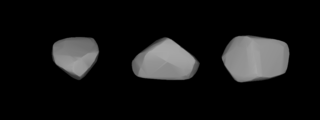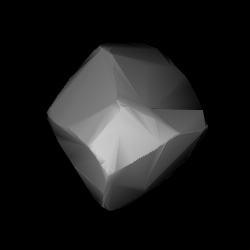Related Research Articles

588 Achilles is a large Jupiter trojan asteroid of the Greek camp. Achilles was the first Jupiter trojan to be discovered, and was discovered by Max Wolf at the Heidelberg Observatory in 1906. Wolf named the minor planet after the legendary hero Achilles from Greek mythology. The dark D-type asteroid measures approximately 133 kilometers in diameter which makes it one of the 10 largest Jupiter trojans. It has a rotation period of 7.3 hours and possibly a spherical shape.

748 Simeïsa is a very large Hilda asteroid from the outermost regions of the asteroid belt, approximately 104 kilometers in diameter. It was discovered on 14 March 1913, by Russian astronomer Grigory Neujmin at the Simeiz Observatory on the Crimean peninsula. The dark P-type asteroid has a rotation period of 11.9 hours and a shape that is reminiscent of a tetrahedron. It was the first asteroid discovery made in Russia and named after the discovering observatory and its nearby Crimean town, Simeiz.

882 Swetlana is a dark background asteroid from the outer region of the asteroid belt. It was discovered on 15 August 1917, by Russian astronomer Grigory Neujmin at the Simeiz Observatory on the Crimean peninsula. The X-type asteroid has a longer-than average rotation period of 29.9 hours and measures approximately 42 kilometers in diameter. The origin of the asteroid's name remains unknown.
969 Leocadia is a very dark background asteroid from the inner regions of the asteroid belt, approximately 19 kilometers in diameter. It was discovered on 5 November 1921, by Russian astronomer Sergey Belyavsky at the Simeiz Observatory on the Crimean peninsula. The uncommon F-type asteroid (FX) has a rotation period of 6.9 hours and is likely regular in shape. Any reference of the asteroid's name to a person is unknown.
978 Aidamina, provisional designation 1922 LY, is a dark background asteroid from the outer region of the asteroid belt, approximately 79 kilometers in diameter. It was discovered by astronomer Sergey Belyavsky in 1922, and later named after Aida Minaevna, a friend of the discoverer's family.
Belopolskya, provisional designation 1923 OS, is a dark Cybele asteroid from the outermost region of the asteroid belt, approximately 75 kilometers (47 mi) in diameter. It was named for Russian astrophysicist Aristarkh Belopolsky.
1057 Wanda, provisional designation 1925 QB, is a carbonaceous background asteroid from the outer region of the asteroid belt, approximately 43 kilometers in diameter. It was discovered by Grigory Shajn at the Simeiz Observatory in 1925, and later named after Polish–Soviet writer Wanda Wasilewska. The asteroid has a rotation period of 28.8 hours.
1099 Figneria, provisional designation 1928 RQ, is an asteroid from the background population of the outer regions of the asteroid belt, approximately 26 kilometers in diameter. Discovered by Grigory Neujmin at Simeiz Observatory in 1928, the asteroid was later named after Russian revolutionary activist Vera Figner.
1113 Katja, provisional designation 1928 QC, is a background asteroid from the outer regions of the asteroid belt, approximately 39 kilometers in diameter. It was discovered by Pelageya Shajn at the Simeiz Observatory in 1928, and named after Ekaterina Iosko, a staff member at the discovering observatory.

1140 Crimea, provisional designation 1929 YC, is a stony asteroid from the middle region of the asteroid belt, approximately 28 kilometers in diameter. It was discovered on 30 December 1929, by Soviet astronomer Grigory Neujmin at Simeiz Observatory on the Crimean peninsula, after which it was named.
1166 Sakuntala, provisional designation 1930 MA, is a stony background asteroid from the central regions of the asteroid belt, approximately 26 kilometers in diameter. Discovered by Praskovjya Parchomenko at Simeiz Observatory in 1930, the asteroid was named after the figure of Shakuntala from an ancient Indian drama.

1390 Abastumani is a very large and dark background asteroid from the outer region of the asteroid belt. It was discovered on 3 October 1935, by Russian astronomer Pelageya Shajn at the Simeiz Observatory on the Crimean peninsula. The primitive P-type asteroid has a rotation period of 17.1 hours and measures approximately 101 kilometers in diameter. It was named for the Georgian town of Abastumani.
1280 Baillauda, provisional designation 1933 QB, is a dark background asteroid from the outermost region of the asteroid belt, approximately 52 kilometers in diameter. Discovered by Eugène Delporte at Uccle Observatory in 1933, the asteroid was named after French astronomer Jules Baillaud.
1609 Brenda, provisional designation 1951 NL, is a stony asteroid from the central region of the asteroid belt, approximately 28 kilometers in diameter. It was discovered on 10 July 1951, by South African astronomer Ernest Johnson at the Johannesburg Observatory in South Africa, and named after his granddaughter, Brenda.
2363 Cebriones is a large Jupiter trojan from the Trojan camp, approximately 84 kilometers in diameter. It was discovered on 4 October 1977, by astronomers at the Purple Mountain Observatory in Nanking, China. The dark D-type asteroid is one of the 40 largest Jupiter trojans and has a rotation period of 20 hours. It was named after Cebriones, Hektor's charioteer from Greek mythology.

1277 Dolores is a carbonaceous background asteroid from the central regions of the asteroid belt, approximately 27 kilometers in diameter. It was discovered on 18 April 1933, by Soviet astronomer Grigory Neujmin at the Simeiz Observatory on the Crimean peninsula. The asteroid was named after Spanish communist Dolores Ibárruri.

1283 Komsomolia is a metallic background asteroid and potentially slow rotator from the outer regions of the asteroid belt. Discovered by Vladimir Albitsky in 1925, it was later named after Komsomol, a political youth organization of the former Soviet Union. The M-type asteroid has roughly a rotation period 96 hours of and measures approximately 30 kilometers in diameter.
1255 Schilowa, provisional designation 1932 NC, is a background asteroid from the outer regions of the asteroid belt, approximately 34 kilometers in diameter. It was discovered on 8 July 1932, by Soviet astronomer Grigory Neujmin at the Simeiz Observatory on the Crimean peninsula. The asteroid has a longer-than average rotation period of 29.5 hours. It was named after Mariya Zhilova (Schilowa), who was Russia's first professional female astronomer.
1734 Zhongolovich, provisional designation 1928 TJ, is a carbonaceous Dorian asteroid from the central region of the asteroid belt, approximately 28 kilometers in diameter.

1236 Thaïs is a dark background asteroid from the inner regions of the asteroid belt. The rare T-type asteroid has a notably long rotation period of 72 hours and measures approximately 18 kilometers. It was discovered on 6 November 1931, by Soviet astronomer Grigory Neujmin at Simeiz Observatory on the Crimean peninsula, and named after the ancient Greek prostitute Thaïs.
References
- 1 2 3 4 5 6 7 "JPL Small-Body Database Browser: 1167 Dubiago (1930 PB)" (2017-07-05 last obs.). Jet Propulsion Laboratory . Retrieved 26 July 2017.
- 1 2 3 Schmadel, Lutz D. (2007). "(1167) Dubiago". Dictionary of Minor Planet Names – (1167) Dubiago. Springer Berlin Heidelberg. p. 98. doi:10.1007/978-3-540-29925-7_1168. ISBN 978-3-540-00238-3.
- 1 2 3 4 "LCDB Data for (1167) Dubiago". Asteroid Lightcurve Database (LCDB). Retrieved 1 February 2017.
- 1 2 3 4 Tedesco, E. F.; Noah, P. V.; Noah, M.; Price, S. D. (October 2004). "IRAS Minor Planet Survey V6.0". NASA Planetary Data System – IRAS-A-FPA-3-RDR-IMPS-V6.0. Bibcode:2004PDSS...12.....T . Retrieved 17 October 2019.
- 1 2 3 4 Usui, Fumihiko; Kuroda, Daisuke; Müller, Thomas G.; Hasegawa, Sunao; Ishiguro, Masateru; Ootsubo, Takafumi; et al. (October 2011). "Asteroid Catalog Using Akari: AKARI/IRC Mid-Infrared Asteroid Survey". Publications of the Astronomical Society of Japan. 63 (5): 1117–1138. Bibcode:2011PASJ...63.1117U. doi:10.1093/pasj/63.5.1117. (online, AcuA catalog p. 153)
- 1 2 Dahlgren, M.; Lagerkvist, C.-I.; Fitzsimmons, A.; Williams, I. P. (May 1991). "Differential CCD photometry of Dubiago, Chiron and Hektor". Monthly Notices of the Royal Astronomical Society. 250: 115–118. Bibcode:1991MNRAS.250..115D. doi: 10.1093/mnras/250.1.115 . ISSN 0035-8711 . Retrieved 1 February 2017.
- 1 2 3 Waszczak, Adam; Chang, Chan-Kao; Ofek, Eran O.; Laher, Russ; Masci, Frank; Levitan, David; et al. (September 2015). "Asteroid Light Curves from the Palomar Transient Factory Survey: Rotation Periods and Phase Functions from Sparse Photometry". The Astronomical Journal. 150 (3): 35. arXiv: 1504.04041 . Bibcode:2015AJ....150...75W. doi:10.1088/0004-6256/150/3/75 . Retrieved 1 February 2017.
- ↑ Veres, Peter; Jedicke, Robert; Fitzsimmons, Alan; Denneau, Larry; Granvik, Mikael; Bolin, Bryce; et al. (November 2015). "Absolute magnitudes and slope parameters for 250,000 asteroids observed by Pan-STARRS PS1 - Preliminary results". Icarus. 261: 34–47. arXiv: 1506.00762 . Bibcode:2015Icar..261...34V. doi:10.1016/j.icarus.2015.08.007 . Retrieved 1 February 2017.
- 1 2 "1167 Dubiago (1930 PB)". Minor Planet Center. Retrieved 1 February 2017.
- ↑ "JPL Small-Body Database Search: list of D-type minor planets (Tholen/SMASSII)". Jet Propulsion Laboratory. Retrieved 5 November 2015.
- ↑ Schmadel, Lutz D. (2009). "Appendix – Publication Dates of the MPCs". Dictionary of Minor Planet Names – Addendum to Fifth Edition (2006–2008) . Springer Berlin Heidelberg. p. 221. doi:10.1007/978-3-642-01965-4. ISBN 978-3-642-01964-7.